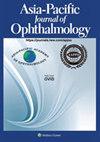Geographic atrophy: Understanding the relationship between structure and function
IF 4.5
3区 医学
Q1 OPHTHALMOLOGY
引用次数: 0
Abstract
Purpose
This review explores the complex relationship between anatomical alterations and functional consequences in geographic atrophy (GA), the advanced non-neovascular form of age-related macular degeneration. We examine the natural history, progression patterns, structural biomarkers, functional assessments, and structure-function correlations in GA.
Methods
Experts contributed specialized knowledge on GA pathophysiology, imaging biomarkers, and functional assessment methods. We synthesized an understanding of the relationship between structural changes (including fundus autofluorescence patterns, optical coherence tomography markers, and novel biomarkers) and functional outcomes (visual acuity, microperimetry, reading performance, and patient-reported outcomes), drawing from authors' research expertise and relevant literature.
Results
While GA is defined by visible areas of outer retinal atrophy, the structure-function relationship is complex and often discordant. Visual acuity incompletely reflects the functional impact of GA, as it may remain preserved until foveal involvement occurs. Microperimetric assessments reveal functional deficits extending beyond visible atrophic borders, with varying degrees of correlation between structural and functional metrics. Different fundus autofluorescence patterns demonstrate distinct functional implications and progression rates. Recent innovations in imaging and visual function testing offer enhanced characterization of disease progression.
Conclusions
The complex relationship between structural and functional measures in GA reflects underlying pathophysiological mechanisms and has important implications for clinical trial endpoints and patient management. Multimodal assessment incorporating both structural and functional parameters is essential for the comprehensive evaluation and management of GA, particularly as novel therapeutic approaches emerge.
地理萎缩:理解结构与功能的关系。
目的:本综述探讨地理萎缩(GA)的解剖改变和功能后果之间的复杂关系,GA是年龄相关性黄斑变性的晚期非新生血管形式。我们研究了GA的自然历史、进展模式、结构生物标志物、功能评估和结构-功能相关性。方法:专家们贡献了GA病理生理学、成像生物标志物和功能评估方法的专业知识。我们综合了结构变化(包括眼底自身荧光模式、光学相干断层扫描标记物和新型生物标记物)和功能结果(视力、显微视野、阅读表现和患者报告的结果)之间的关系,借鉴了作者的研究专长和相关文献。结果:虽然GA是由可见的视网膜外萎缩区域定义的,但结构-功能关系复杂且经常不协调。视力不能完全反映GA的功能影响,因为它可能一直保留到中央凹受累。微周评估显示功能缺陷延伸到可见的萎缩边界之外,结构和功能指标之间存在不同程度的相关性。不同的眼底自身荧光模式显示出不同的功能含义和进展速度。最近在成像和视觉功能测试方面的创新提高了疾病进展的表征。结论:GA的结构和功能测量之间的复杂关系反映了潜在的病理生理机制,对临床试验终点和患者管理具有重要意义。结合结构和功能参数的多模式评估对于GA的综合评估和管理至关重要,特别是随着新的治疗方法的出现。
本文章由计算机程序翻译,如有差异,请以英文原文为准。
求助全文
约1分钟内获得全文
求助全文
来源期刊

Asia-Pacific Journal of Ophthalmology
OPHTHALMOLOGY-
CiteScore
8.10
自引率
18.20%
发文量
197
审稿时长
6 weeks
期刊介绍:
The Asia-Pacific Journal of Ophthalmology, a bimonthly, peer-reviewed online scientific publication, is an official publication of the Asia-Pacific Academy of Ophthalmology (APAO), a supranational organization which is committed to research, training, learning, publication and knowledge and skill transfers in ophthalmology and visual sciences. The Asia-Pacific Journal of Ophthalmology welcomes review articles on currently hot topics, original, previously unpublished manuscripts describing clinical investigations, clinical observations and clinically relevant laboratory investigations, as well as .perspectives containing personal viewpoints on topics with broad interests. Editorials are published by invitation only. Case reports are generally not considered. The Asia-Pacific Journal of Ophthalmology covers 16 subspecialties and is freely circulated among individual members of the APAO’s member societies, which amounts to a potential readership of over 50,000.
 求助内容:
求助内容: 应助结果提醒方式:
应助结果提醒方式:


